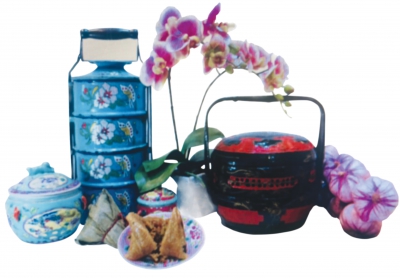Her Story In The Making
Author:Nyonya Linda Chee
BABA RAYMONG WONG OF THE KIM CHOO KUEH CHANG FAMILY HAS LIVED AND BREATHED BAKCHANG ALL HIS LIFE HE SHARES STORIES OF HIS PIONEERING GRANDMOTHER.
It all started with one determined Nyonya who did not want to lose a child. Angry with her son-in-law for wanting to give his daughter away in faraway Terengganu, she instructed her son to make a trip there and bring her grandchild to Singapore. She adopted the girl as her own daughter, passing on the finer points of making nyonya bakchang, or dumpling, to her. That child was Lee Kim Choo.
Kim Choo was born in Terengganu in 1933 to a dried seafood trader surnamed Lee. He thought she brought bad luck because his business did badly, and he fell into ill health. Fortunately for Kim Choo, she had a stable and happy childhood under the care of her grandmother, Tok Siew Neo, in Singapore. “She had a strong bond with my great-great-grandmother (who we referred to as our Cho Cho).” Said Kim Choo’s grandson, Raymond Wong.

Kim Choo Dumplings
The Dumpling Festival was one of the four main festivities of the year for the Chinese, Peranakans included. Great-great-grandmother would buy lots of glutinous rice from the market about a month before the festival,” and task Kim Choo to pick out the white rice grains. “kueh chang abu(Kee Chang) made with glutinous rice will be very lembut, or soft. It will spoil easily if there is any white rice in it.”
The Dumpling Festival takes place on the 5th day of the 5th Lunar month at the beginning of summer, known as the Summer Solstice, the day being the longest and hottest of the Lunar year. Great-great-grandmother would hang a bunch of keechang from the first batch at the front door to herald the coming of the festival, plus a bunch of dried daon aroda (rue herb).
-225x300.jpg)
20世纪80年代初,金珠在如切坊60号店屋售卖娘惹肉粽照片由金珠的孙子Edmond Wong提供)
In the 1960s, many nyonyas in Katong made Kueh for sale from their homes to earn precious income. Kim Choo was the only Nyonya on the streets, selling Nyonya chang under a banyan tree. Raymond feels fortunate that his grandma stayed 15 years with his family at Telok Kurau until 2013, during which she shared many interesting stories about her past. Kim Choo died in 2015.
The family business prospered in the 1970s after Kim Choo moved from under the banyan tree to the shop unit beside it at 60 Joo Chiat Place, where they have stayed since. Raymond’s father spent his childhood in Kampong Joo Chiat helping Kim Choo “to cut wood for the fire. She would throw Chinese coins into the steamer water so that when it came to boiling, the coins would jiggle with the bubbles and make a tinkling noise. Then she would have to tambah ayer panas or add water. It was her timer. My dad remembers because he had to help her top up the water.”
When Kim Choo married, her grandma’s family did not have the luxury of giving a dowry for her marriage. Thus, when she was hawking bakchang, she envied the nyonyas who wore kebayas because she could not afford them. Perhaps to make up for the deprivation, Kim Choo wore two kebayas on the same day, for the first time in her life, at her eldest son Sin Min’s marriage to Helen on 1 April 1976–one at tea ceremony and the other at the wedding dinner.
In 2011, “my grandma asked me, to make a kebaya for her,” remembered Raymond, who was fast gaining a reputation as a kebaya designer. “It was her first and only kebaya sulam (embroidery) made by me. She said she wanted to be dressed in the kebaya when she died.” Raymond was taken aback, but when the time came, “we fulfilled her wish.”
(Source: Linda Chee, Her story in the making, THE PERANAKAN Magazine Year 2021 Issue 1))
白手起家——金珠的创业故事
文 · 陈琳达 图 · Edmond Wong
峇峇黄俊荣,来自本地著名的“金珠肉粽”家族,从小就闻着粽子的香气长大,他为我们讲述了祖母金珠的创业故事。
故事要从一位不愿抛弃孙女的娘惹外祖母说起。远在登嘉楼州(旧译:丁加奴)的女婿想把外孙女送人,她对此感到愤怒,于是吩咐儿子将外孙女带回来新加坡由她亲自抚养。她对这个外孙女视如己出,还把制作娘惹肉粽的秘方倾囊相授。外孙女名叫李金珠,正是本地知名品牌“金珠肉粽”的创始人。
金珠于1933年生于马来西亚登嘉楼州,她的父亲姓李,是一位经营海鲜干货的商人。他认为女儿的出生给自己带来了厄运,导致自己生意不景气,身体也出现问题。幸好,金珠在外祖母卓秀娘的收留与照顾下度过了一个安定快乐的童年。据金珠的孙子黄俊荣回忆:“奶奶和祖祖(Cho-Cho)(子孙们对高外祖母的尊称)感情深厚”。
端午节是华人包括土生华人在内的四大传统节日之一。高外祖母在端午节开始前一个月左右便会去市场买糯米,然后会吩咐金珠把里面的白米粒挑出来。“糯米做出来的碱水粽非常松软,但里面不能有任何白米,否则非常容易变质。”
每年农历五月初五是端午节,正值夏日的开始,也就是夏至,是全年最热最长的一天。高外祖母会把做好的第一批碱水粽中的一串和芸香干草一起挂到大门上,昭告端午的到来。
在20世纪60年代,加东的很多娘惹都会售卖在家中自制的糕点来挣外快,而金珠是唯一一位在街头榕树下售卖娘惹肉粽的娘惹。黄俊荣很庆幸祖母能和他全家在直落古楼区同住十五年,直到2013。在此期间,祖母向他讲述了自己经历的种种趣事。金珠于2015年辞世。
在20世纪70年代,金珠把肉粽生意从榕树下搬到了附近如切坊60号的店铺,直到今天仍在此处营业。黄俊荣的父亲小时候经常要在店里帮忙母亲“砍柴生火”。祖母会把一枚铜钱丢进蒸锅里,当水烧开时,铜钱也会随之翻滚,发出叮叮当当的响声。就像计时器一样提醒祖母该添热水了。父亲因需要不停地帮祖母往锅中加水,所以对此一直记忆犹新。

金珠身着可巴雅,摄于2003年
金珠出嫁时,她的外祖母家无法为她预备一份丰厚的嫁妆。因此,在她售卖娘惹肉粽的日子里,总是羡慕那些可以穿得起精美可峇雅(Kebaya:娘惹女性上衣)的娘惹。或许是为了弥补过去的遗憾,在她大儿子与儿媳妇的婚礼上,她一天就穿了两件不同的可峇雅,一件是在敬茶环节,一件则在婚宴环节。
2011年的时候,黄俊荣回忆道,“祖母希望我能为她做一件可峇雅。”那时他已是一名声名鹊起的可峇雅设计师。“那是她第一件,也是唯一一件由我制作的刺绣可峇雅。她说她希望去世时可以穿着这件可峇雅下葬。”当时黄俊荣被祖母的这番话吓到了,但当那一天真的到来时,“我们还是帮祖母完成了她的夙愿。”

金珠与长子一家,后排从左到右:孙子黄鼎翔、黄俊荣、黄星原,孙女黄可奇;前排:长子黄信民、李金珠、长媳林木洁
(本文为翻译比赛英译中获奖作品,由南洋女子中学校李瑞婳、王怡菲、杨祉媛翻译。原文作者陈琳达,刊载于THE PERANAKAN杂志,2021年第1期))






